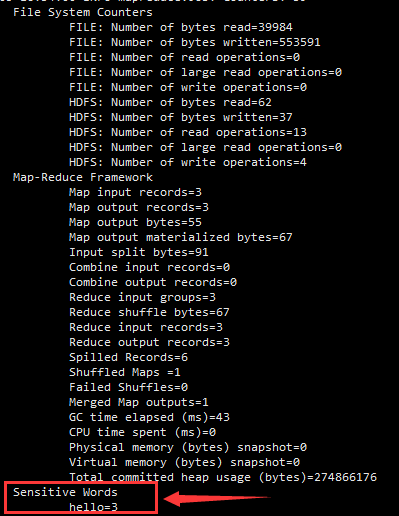1,计数器:
显示的计数器中分为四个组,分别为:File Output Format Counters、FileSystemCounters、File Input Format Counters和Map-Reduce Framkework。
分组File Input Format Counters包括一个计数器Bytes Read,表示job执行结束后输出文件的内容包括的字节数(空格、换行都是字符)

关于以上这段计数器日志中详细的说明请见下面的注释:
2,自定义计数器:
由于不同的场景有不同的计数器应用需求,我们可以自定义不同的计数器:
一:敏感词准备:

将文件中的hello设为敏感词,自定义计数器的目的是将文件中出现的计数器的次数给记录出来
二:代码部分:
仅需要修改之前博客中WordClass中的map的代码部分:
public class WordClass { public static class MyMapper extends org.apache.hadoop.mapreduce.Mapper<LongWritable, Text, Text, LongWritable> { protected void map(LongWritable key, Text value, Mapper<LongWritable, Text, Text, LongWritable>.Context context) throws IOException, InterruptedException { //动态申明
Counter sensitiveCounter = context.getCounter("Sensitive Words", "hello"); String line = value.toString(); //假设hello是一个敏感词 if (line.contains("hello")){ sensitiveCounter.increment(1L); } String[] split = line.split(" "); for (String word : split) { context.write(new Text(word), new LongWritable(1)); } } }
计数器声明
1.通过枚举声明 context.getCounter(Enum enum)
2.动态声明 context.getCounter(String groupName,String counterName)
计数器操作
counter.setValue(long value);//设置初始值
counter.increment(long incr);//增加计数
三:结果

在日志信息中可以看到文件中的敏感词信息
3,Combiner的使用
Combiner的作用就是在map端对数据进行合并,从而提高网络的通讯速率,减少map到reduce的网络带宽
我们可以本地把Map的输出做一个合并计算,把具有相同key的数据做一个计算,然后再把此输出作为reduce的输入,这样传给reduce的数据就少了很多。Combiner是用reducer来定义的,多数的情况下Combiner和reduce处理的是同一种逻辑,所以job.setCombinerClass()的参数可以直接使用定义的reduce,括号中可以直接传入类似于MyReducer.Class,当然也可以单独去定义一个有别于reduce的Combiner,继承Reducer,写法基本上定义reduce一样。
----那么,既然Combiner这么有用为什么不能将它作为默认设置呢?
----因为当有类似于求平均数的任务时,在map端执行Combiner会影响最终的结果,所以有些操作并不适合用Combiner,在工作使用中我们应该先选取小部分的数据进行测试,如果结果无误的话,则可以使用Combiner进行map端的数据合并
